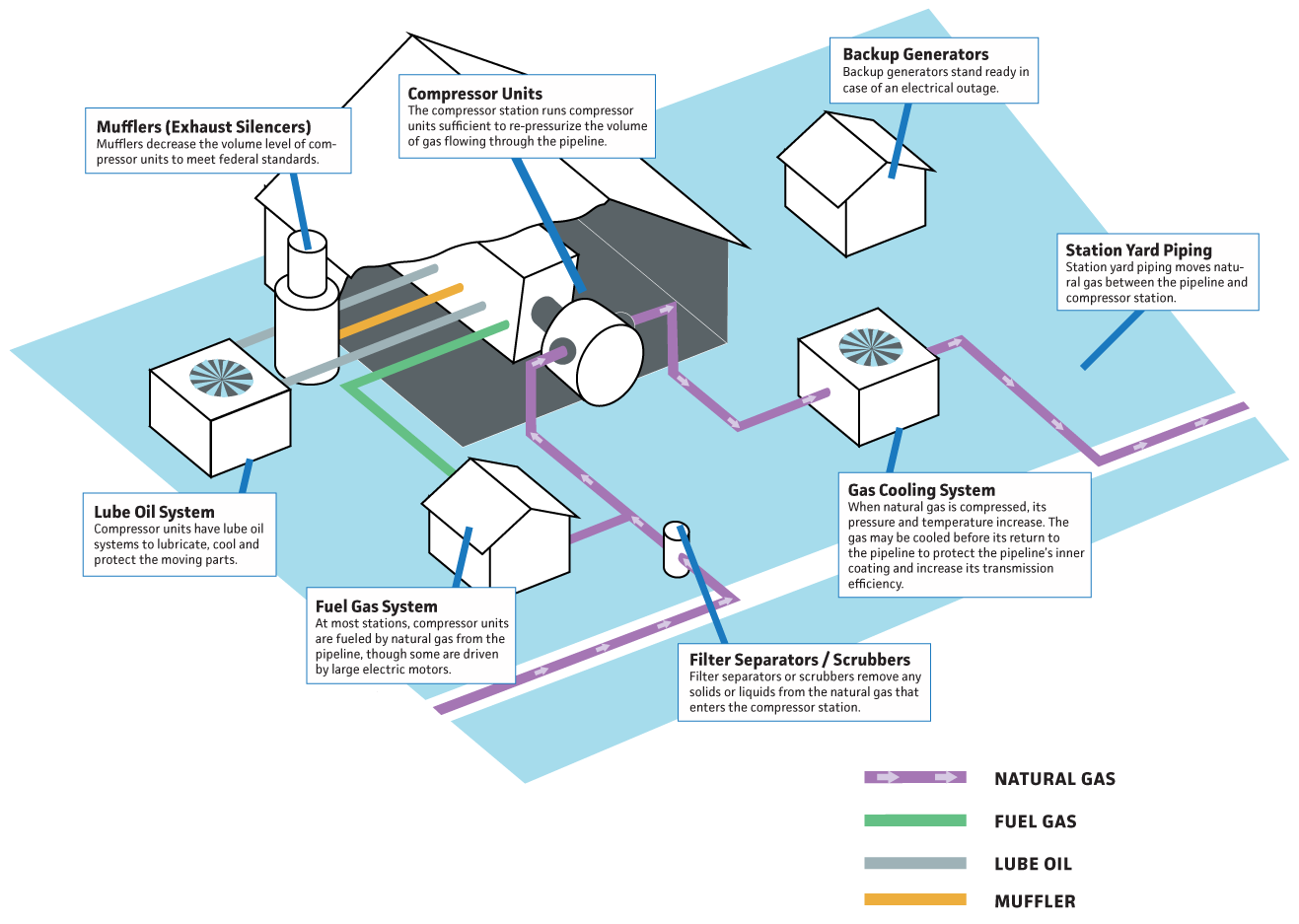Transporting Natural Gas
Pipelines are the safest way to transport natural gas.
The transportation system for natural gas consists of a complex network of pipelines, designed to quickly and efficiently transport natural gas from its origin to where it’s needed.
There are three major types of pipelines along the transportation route: gathering pipelines, interstate pipelines and distribution pipelines. Gathering systems consist of low-pressure, small-diameter pipelines that transport raw natural gas from the wellhead to the processing plant.
Interstate pipelines are similar to the interstate highway system, carrying natural gas across state boundaries, and in some cases, across the country. Conversely, intrastate pipelines are located within the borders of one state. This distinction determines which agency will oversee the regulation of a particular pipeline.
Project Information:
Compressor Stations
Natural gas is highly pressurized as it travels through a pipeline. To ensure the natural gas remains pressurized, it must be compressed periodically along the pipeline. This is accomplished by using compressor stations where gas is compressed either by a turbine, a motor or an engine.
To ensure optimal flow through the interstate pipeline system, natural gas must be periodically compressed and pushed through the pipeline.
Over extended distances, friction and elevation differences reduce the pressure within the pipeline and slow the flow of gas. That’s where compressor stations play a significant role. There are hundreds of compressor stations across North America, placed roughly 50 to 70 miles apart along the transmission pipeline system, that give the gas a needed “boost” helping it get from one point to the next. These stations operate twenty-four hours a day, 365 days a year and are monitored 24/7 by highly-trained personnel as well. There are hundreds of compressor stations across the U.S. that play an integral role in the natural gas transmission system, which is proven to be the safest and most reliable way to transport natural gas.
Compressor Station Overview
(Click on the image for larger display.)

How They Work
Learn more about how compressor stations work.
Safety and Emergency Shutdowns
Compressor stations employ a variety of safety systems and practices to protect the public, employees and our facilities.
For example, every station has an emergency shutdown system that stops the compressor units, isolates and vents the compressor station gas piping, and diverts gas in the pipeline around the station.
All compressor stations are monitored around the clock by highly-trained personnel at a centralized gas control center. In addition, all emergency shutdown systems are fully tested annually per Department of Transportation regulations.
We also work closely with first responders to ensure they are aware of our operations and are able to assist in the unlikely event of an emergency.
Air Quality
Compressor stations are highly regulated facilities that must meet rigorous safety and air quality standards.
Turbines that drive the gas compressors use low-emission technology and are fueled by clean-burning natural gas. Current federal regulations require the turbines to be designed to achieve a nitrogen oxide (NOx) emission rate of 25 ppmvd (parts per million by volume, dry basis) during normal operations. New turbines are designed to achieve a NOx emission rate of 9 ppmvd during normal operations. This is significantly lower than what is required by federal and state regulations.
Additionally in the event that natural gas is released from the compressor station, either during annual testing or during an emergency shutdown, the natural gas – a mixture of hydrocarbons, primarily methane – will rise and dissipate safely as it is absorbed into the atmosphere because methane is lighter than air.
Noise and Odor
The Federal Energy Regulatory Commission (FERC) regulates interstate pipeline compressor stations and requires that the station’s noise levels do not exceed an average day-night sound level (Ldn) of 55 decibels (dBA) at the nearest noise sensitive area, e.g., residences, schools, hospitals, churches, playgrounds and camping facilities, when operating at full load.
Noise surveys are conducted before and after construction to verify these federal noise levels are not exceeded. As a point of reference, the average home dishwasher is 50 dBA.
Natural gas is odorless and colorless. However, in some pipelines, an odorant called Mercaptan is injected into the natural gas for safety reasons. Mercaptan creates a recognizable odor, often compared to rotten eggs, which helps to identify or detect a leak. It is not harmful and will dissipate. During annual testing of the emergency shutdown system or in the unlikely event that an emergency shutdown occurs, the odor from the Mercaptan may be detectable. In some cases, the smell of Mercaptan may linger if minute traces of the odorant separate from natural gas that has risen and been absorbed into the atmosphere.








